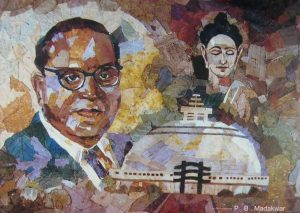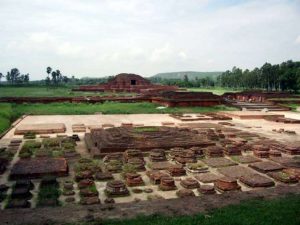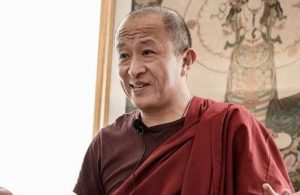Monday, 29th October
We then went to the nearby villa which had belonged to Chairman Mao. It is now a fairly plain and simple museum displaying some wonderful photographs. Nearby outside was a man-made lake underneath which lies the Great Woods Temple. It was in 1951 that Master Xu Yun (Empty Cloud) was staying there when he heard about the nearby Zhen Ru Chan Monastery in Jiangxi province which had been destroyed by the Japanese army, and he went there to restore it at the end of his very long life.
Tuesday, 30th October
In the morning we had a long drive to the 5th Patriarch’s monastery. We spent a couple of hours looking around. A lot of building work had been completed since my first visit to it in 2010 but there was still a lot more going on. We had lunch in the new vegetarian restaurant. It was fantastic and cost £15 for six of us.
We then drove to the Old Ancestors’ Chan Monastery, high up on Yellow Plum Mountain. We spent a couple of hours looking at this place where many Chan teachers have stayed. It is brand new – a perfect architectural masterpiece of a traditionally-styled Chinese Buddhist Monastery. Not much was going on there. High up in the mountain stillness it was easy to feel above the ‘Red Dust of the World’. There was a rather excellent gift shop there so we all went in and bought CDs, incense, etc.
After photos outside, we drove down the mountain to the 4th Chan Patriarch’s Monastery, just in time to check in before supper. In the evening we went to the meditation halls; there are now two, one for men and one for women. This had changed from a communal hall since my last visit in 2010. So I went to the new men’s hall with our driver Shao Hu who was a good roommate and had overcome his shyness with me. We could now communicate easily on a basic level of Mandarin together with a few English words that he knew.
Wednesday 31st October
We went to morning chanting at 5am; it lasted one hour and ten minutes. This led straight into a formal breakfast. Master Dong was still sleeping, unwell with a rotten tooth. We all went to another excellent and cheap gift shop, buying clothes, shoes, incense etc. Afterwards we walked up to the cave where the Chan Dharma was transmitted from the 4th to the 5th Patriarch. We spent some time enjoying the atmosphere there. Then we went back down the long steps for lunch, then left the Monastery to drive to Anhui Province.
In Anhui we went to the Yue Si branch of Miss Lee’s company. They were building ‘Heavens Bay’, a large cultural centre with a budget of two billion English pounds. When we met the local boss at the motorway junction, He Han went to his car, but he just drove off leaving her, the ‘big boss’, standing helplessly alone on the busy road, showing no embarrassment. She just shrugged it off as a joke. We went to the local head office where we were shown a model of the plans and taken upstairs for some very good green tea for a couple of hours. We were told that the project is now at stage two and will be complete in five to six years. It is named after the Second Chan Patriarch, Hui Ke’s, ‘House of Wisdom’. We were told how things are developing politically and socially in China. The project, we learnt, is to help society become more humanistic, kind and eco-friendly. It will contain a school and a home for old people, amongst other cultural treasures of Chinese life. We expressed no views and just listened, refusing cigarettes, so nobody smoked – luckily, as they did almost everywhere else. I noticed the main photo on the wall behind us was of the company boss of all five branches, whilst Chairman Mao was in a smaller battered old frame in a corner of the room.
Next we went to a nearby monastery under total reconstruction. We were treated so well again, and then met a Buddhist friend of Miss Lee’s called John, who was also involved in the Heavens Bay project. He had just returned from Tibet where he had special visas to visit restricted areas. He showed us his photos enthusiastically and spoke very good English. He knew a lot about Chan and the early Patriarchs. We were given Sword Leaf tea, usually reserved for the Russian diplomats and other dignitaries, we were told. The tea was kept locked in a store room. We had supper there with a crowd of building workers in a makeshift canteen. The electricity went off during the meal for a short while but candles were quickly found.
Later in Hu Fei we checked into a hotel. Then I was told that in two days I would give a talk to a couple of hundred people from the Government, army, monks and other people, many from prominent positions, who would be at the opening ceremony with a big press gathering. He Han (Miss Lee) would translate. I helped Master Dong shave his head and we went to bed.
Thursday 1st November
Got up, had breakfast and drove to the 3rd Patriarch’s monastery. This was a great ramshackle old place with a wonderful atmosphere. The Abbot, a friend of Miss Lee, gave us a lot of time. We went to the only vegetarian restaurant in the town nearby. Then we went back to the monastery and learnt a lot about the Chan history there. He taught us about the Faith in a mind poem written by the 3rd Patriarch, who we were told had waited there twenty years before finding someone to hand on the teaching to, when a twelve year old boy arrived and understood it straight away. Then, nine years later he passed him the robe and bowl (symbols of the lineage). The boy went on to become Chan Master Dao Shin, the 4th Patriarch, who made the Chan sect grow into a large monastery from the earlier collections of huts and caves which his predecessors had lived in. The Abbot told us how the north of Anhui province was mainly Christian now, with each convert expected to find a hundred or two hundred other people to convert. He also told us how on special days 5,000 people would sometimes turn up at the Monastery in south Anhui. Often he could not even get in the restaurant for lunch but he didn’t mind as he was happy that the Buddha Dharma was growing again in China, even if the Christians were growing faster. The Christians in China apparently now call the Buddhists ‘The hungry ghosts from hell’ – we had learnt this the year before.
We all drank Pu Er ‘Kung Foo’ tea around a large impressive tea table. When the teaching was simple I translated. At other times He Han translated; sometimes we had to use Japanese to get the meaning clear. The Abbot looked surprised when I spoke to Miss Lee in another language and she explained that sometimes it was the only way to get certain ideas across. There was no complicated theory here though; the Chan here is simple, straight forward and direct. Just wake up to your own mind.
We walked up to the Sharia pagoda at the back of the old monastery. There was such an amazing atmosphere with the old buildings huddled around the pagoda. Then we went down to the front of the site where they were rebuilding the main hall. I was keen to go and meet the carpenters. They were from a company in Xian who had been among over sixty companies bidding for the contract to build a wooden-framed main hall using traditional methods. They all had to take exams and provide references and work history in order to compete. There was only one contract winner, the company who are now busy at work, using African redwood which had come to China by ship. I was given the privilege of helping chisel out a roof bracket. So you can say that I helped rebuild the 3rd Patriarch’s Monastery in a very small way.
The Abbot told us that we would be welcomed to the opening ceremony in eighteen months’ time and would be given VIP status if we came. We showed him photos of our hermitage in Wales and he said he would like to book in for one week if he ever comes to the UK.
The Chan Ancestor Monastery tour over, we then drove to Hu Fei, the capital of Anhui province. We had been reserved rooms in a hotel but as it was an army hotel foreigners were not allowed to stay there. We were easily moved to another very nice hotel nearby. The next morning we went to the Dai Bei Shan Cultural Research Academy opening ceremony. We were given name tags and a ticket for a wonderful tea set in a presentation box. Sitting through the opening speeches we saw high ranking government officials, army officers, monks, nuns and academics.
After lunch I was invited with others to do some calligraphy with a large brush. Very pretty girls came around from time to time, in tight fitting traditional Chinese chipao, topping up our tea mugs with hot water from thermos flasks. The older participants dozed. Then I gave a talk on Buddhism in the UK and about my Buddhist life. Miss Lee translated; she obviously said the right things as there was a good response, with one monk leaping to his feet, nearly knocking Sam off her chair in his enthusiasm to shake my hand. All of us speakers then had to sign a beautiful long commemoration scroll.
The next morning we drove back to Cloud Abode mountain. This part of our pilgrimage to China was over and Miss Lee (He Han) took a taxi back to nearby Lu Shan. The roads were terrible as many are being rebuilt. It took all day and we were shaken to bits. As soon as we arrived at Chen Ru Chan Monastery I was asked to give a talk to around two hundred people with Master He Dong and another monk. We had supper with the Abbot Chen Wen and I went to the Meditation Hall for the long evening meditation, going to sleep to the sound of the evening bell. Then very early the very next morning we flew to Shenzhen for a meditation retreat.
TO BE CONTINUED…














